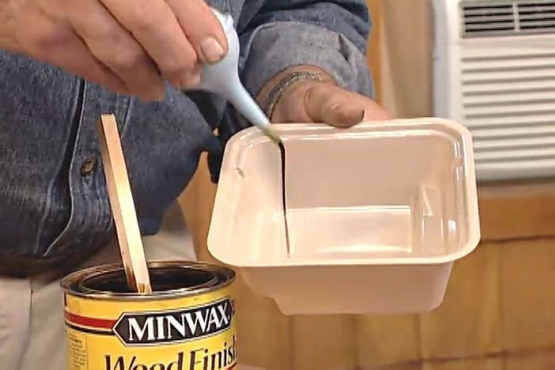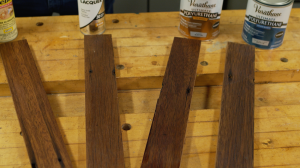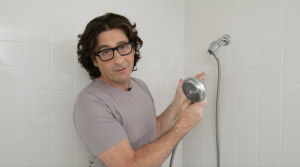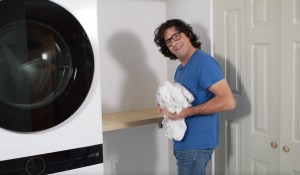RON HAZELTON:
A little while ago I widened this doorway from here out to here and then put in these French doors. I'm really happy with the way this turned out. But when I took this portion of the wall out, of course there was no flooring here. So I had to put new strips in. Now I'm faced with two problems. These strips are slightly higher than the surrounding floor and they're a different color. Well actually they're completely unfinished. So what I need to do is to level this down and try to match the color and finish.
Do you know what this is? Well if you said paint scraper, you'd be absolutely right and now you're wondering why I'd want to use a paint scraper on this job. Well properly prepared, this tool can do a great job of removing thin layers of wood and properly prepared means getting it really sharp.
[Music]
Well in this case, I'm going to bring my sharpening station right to the worksite here. So the first thing, take the paint scraper, put it in our portable vice here. And tighten it up. Now this is a ten inch, maybe this is a 12 inch mill file. What I want to do is just pass this along the edge of the blade like this.
Now if you look really closely here, you see how shiny this is all the way across the blade? That means I'm getting a really sharp edge from one side all the way over to the other.
Well this feels pretty sharp. Let's give it a try here. Start here in the middle where there's a little bit of a ridge. Now if it's working right, we should be kind of like peeling off some wood here. See, that's what I want to see there. Now that's much better by the way than, than dust.
That means that we're actually cutting the wood fibers. Now this is working pretty well you can see. Kind of almost functioning like a plane. However, I'm going to switch to a different tool right up in here. Now this scraper is much narrower and it has a carbide tip right here. Which means it never has to be sharpened and it's great for getting up into tight spots like this.
[MUSIC]
Now as I'm getting up close to the edge of the board here, I've switched to a smaller scraper. Same idea, same shape blade. This gives me a little more precise control.
Well I've gone about as far as I can go with the scraper. I can tell you, this is a workout. What I want to do now is take a random orbital sander. This is a fairly aggressive sander. I want to smooth everything off. And I want to sand off the finish that was on this one plank right here. But I'm going to be very careful only to sand right up to the edge of this plank.
[SANDING SOUNDS]
Well this is coming along just fine. Next step for me is to take some wood filler and fill up some nail holes right here. And then I've got just a couple of places where there's a small gap.
Now my technique for putting the wood filler is to put in enough to fill up the crack or the hole. Maybe slightly over fill it. But not much more because excess just means that's stuff you got to sand off. I use a vibrating palm sander with 100 grit paper for the final smoothing.
Now it's time to remove any dust on the surface. First with a vacuum, and then with a sticky tack cloth made just for this purpose. Alright. Clean, smooth and dust free. Now it's time to put a finish on here. The question is, what color finish.
Now I think these floors have just a clear coating on them but I'm not 100 percent sure. So what I want to do is a little test here to kind of give me an idea of what this would look like with a clear finish on it before I commit to that.
And one way to do that is to put either water or alcohol on the wood and wet it temporarily. I'm going to use the alcohol because it will evaporate very quickly. Now see, if I just put a clear finish on, that's what it's going to probably look like.
As you can see, with just a clear finish, the new wood would be a little lighter or less yellow than adjacent planks. So I'm going to adjust the color by brushing on some shellac that has been thinned with denatured alcohol. At first, the new wood appears too orange.
So I wipe off a bit of the shellac while it's still wet. Well, down to the final step right here. Going to put a clear polyurethane coating on this and it might impart just a touch of color but I don't expect very much. I've poured some of it into this container. This is a semi gloss finish.
Which is I think what's on here. Not, not high gloss. Let's go ahead and brush this on. Oh yeah. Well there we go. And you know what? No one is ever going to know that those boards were new arrivals.









